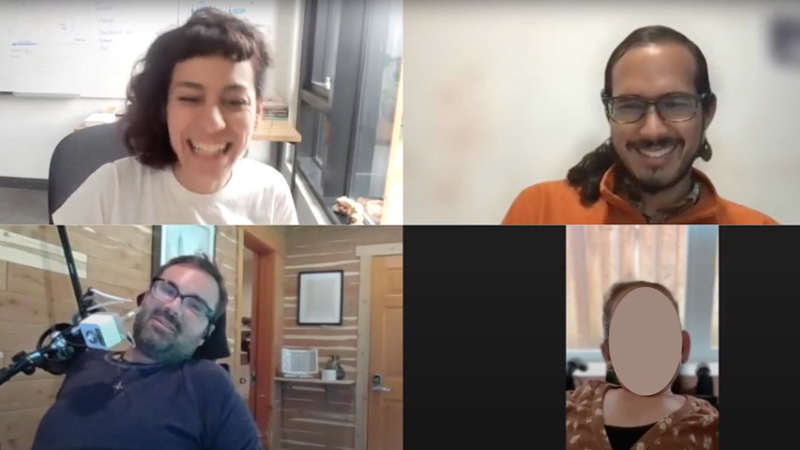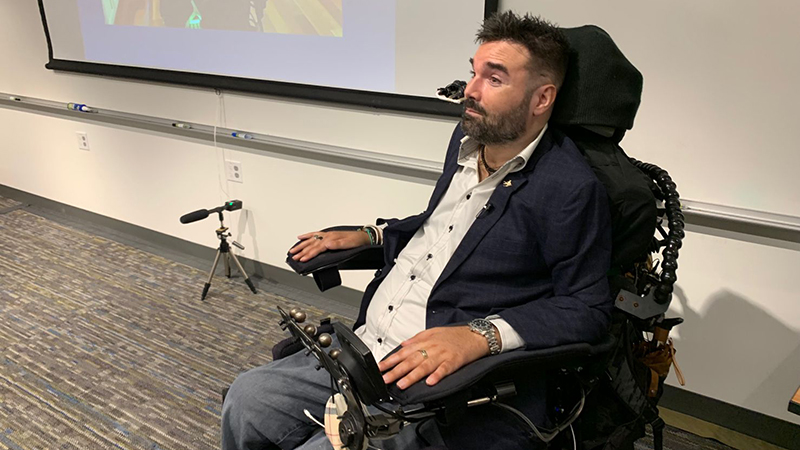
Few occasions better illustrate the human experience than sharing stories over a meal. Yet for people with motor impairments, the act of dining itself can invite undue pressure. Caregivers can get distracted while feeding their clients, who may feel self-conscious about interrupting the ongoing conversations to remind their caregiver to feed them a bite. A simple hangout with friends or family can turn into a source of potential embarrassment. The meal becomes more functional than social — and potentially, a process to be endured rather than a time for celebration.
That’s changing thanks to an innovative partnership between Allen School robotics researchers and the assistive technology nonprofit Tyler Schrenk Foundation. Led by Ph.D. student Amal Nanavati, postdoc Patrícia Alves-Oliveira and community researcher Tyler Schrenk, the group conducted a study using an assistive robot in social dining contexts.
Prior robot-assisted feeding research has focused on the functional aspects of feeding, such as enabling a robot to recognize food on a plate and deliver it to the user’s mouth. But less attention has been devoted to dining’s social aspects, such as etiquette and conversational norms.
For the Allen School team, it was a chance to bring all parties to the table. The roboticists engaged with target users of the technology throughout the technology design process, not just at the end to evaluate the system.
“Too often, we as roboticists develop tools that work well in a lab, but not in the dynamic, nuanced, social environments that users want to use them in,” Nanavati said. “If we truly want to take a user-centered approach to developing robot-assisted feeding systems, we have to meet users where they are and develop for the contexts in which they want to use the technology.”
Nanavati and his co-authors, which also include Ph.D. student Ethan K. Gordon and professors Maya Cakmak and Siddhartha Srinivasa, won the Best Design Paper Award at the 2023 ACM/IEEE International Conference on Human-Robot Interaction (HRI 2023).
As part of the study, which was developed with support from UW CREATE’s student minigrant, the researchers created videos to familiarize participants with robot-assisted feeding systems and to facilitate the conversations around users’ preferred features. After incorporating feedback from participant interviews, they then developed design principles and an implementation guide for robot-assisted social dining to enable other researchers to easily contribute to this space. The design was wholly collaborative, with researchers and participants working together.
“It is an honor to be recognized with a Best Paper Award in a competitive international conference with a work about disabilities and robotics,” Alves-Oliveira said. “It shows that the HRI community recognizes the importance of working equally with a community researcher throughout the research process, and that we have much to learn about designing robotic systems for contexts outside of the lab.”
The team’s community researcher, Tyler Schrenk, was paralyzed in a diving accident in 2012. Since then, he’s become an expert in assistive technology, helping companies in the field empower users and provide greater independence through their creations. As president of the Washington state-based foundation that bears his name, he has helped provide more than $110,000 worth of assistive technologies to individuals with mobility impairments across the world.

Both Nanavati and Alves-Oliveira credited Schrenk for providing crucial insights and helping recruit participants for the study, which is one of the few to involve a “community researcher,” a member of the target community who collaborates with the team throughout the entire research process, from early ideation all the way to research publication.
“I believe the future of caregiving and at-home nursing care is the assistive robotic field,” Schrenk said. “Assistive robotics are a must for those living with disabilities.”
Currently, many challenges affect at-home care. Schrenk pointed to a lack of available caregivers as well as challenges with receiving care that is tailored to one’s needs and preferences. Another hurdle is giving users an increased sense of autonomy. With assistive robots, users would be empowered to complete tasks when they want to and in their own way, augmenting the support that human caregivers can provide them.
“Tyler helped define the direction of the project and provided context for much of the data analysis,” Nanavati said. “This collaboration helped us reach much deeper insights and challenged us to adapt research norms to make them more accessible.”
A meal should be memorable, Alves-Oliveira added, and not for a potential faux pas from the machine. No spilled food, no extraneous movements. First and foremost, the user should be in control.
Together, the team has set the table for a brighter future, a place where everyone feels welcome.
“No matter what culture we belong to, there are moments at the table that can be compared to a sacred ritual — we share important moments of our lives while sharing food,” Alves-Oliveira said. “We discovered that people with motor impairments are missing out on this social exchange because they are distracted by challenges during dining or they avoid social dining altogether. We wanted to bring back this meaningful experience to them with the help of a robot.”
Read the research paper here, watch a video presentation of the work here, and see some of the ways in which robot-assisted social feeding can go wrong here.

